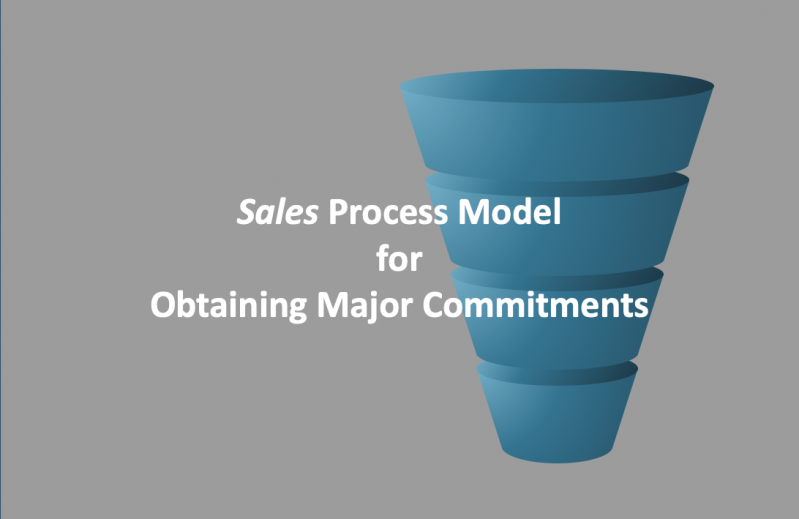This article is one of the most popular ones in my previous format. It presents a model for executive modeling of sales and how to track the progress. I hope to update it and do the next generation soon.
During the past couple of decades, I have refined my model for making large ‘sales.’ By this, I mean ‘sales’ in the generic sense, which is the act of convincing someone or an organization to give you something of significant value – presumably currency – in return for something offered. I sometimes refer to this as the “Ten Touch Sales Model.”
Examples of ‘sales’ might include:
- Corporate Sales
- Products
- Services
- Start-Up and Corporate Fund Raising
- Venture Capital and Equity Placements
- Debt Instruments
- Not-for-Profit Philanthropy
- Scholarships, facilities, and endowments
- Special designations (patrons, benefactors, …)
- ‘Goodwill,’ Tax Benefits
These examples are where one party invests significant amounts of their resources – money, time, future compensation – in return for something so valued. These large ‘sales’ do not happen solely because of marketing, such as advertising, websites, brochures, and mailings. The scale of this transaction typically requires person-to-person interactions and an integrated strategic and tactical plan.
Having worked in the private, non-profit, and government sectors, I was initially surprised by how much the ‘sales’ activities are similar across quite diverse sectors. Seeking large donations for philanthropic activities at not-for-profits is nearly identical to fundraising for venture capital in a corporate setting. Convincing a potential customer to make a significant commitment to your products or services in the corporate environment is remarkably analogous to trying to launch new initiatives for government programs.
Typically, these ‘sales’ activities are complex and involve: person-to-person interactions, relationship building, education, removing obstacles, managing politics, and dealing with other parties that might influence the process.
My conviction is that by developing a simple yet robust model of this process, it is easier to manage and motivate ‘sales’ teams, develop action plans, and report on the results.
I initiated a variation of this 10 Touch ‘Sales’ Model when I was a university president and became involved in significant fundraising for the first time. I later refined that model while raising venture capital for Insitu and then again when we transitioned to product and services sales. I worked with my colleague, Steve Nordlund, while at Insitu to infuse some of his sales expertise into the model. Steve spent part of his career within the sales organization at IBM, and I am certain that some IBM concepts leaked into the model.
The model has its genesis from:
Making a Significant ‘Sale’ Requires 10 Touches
- Touch is defined as a significant, value-added interaction that results in a positive step forward.
- Each touch generally requires about 10 prior contacts.
- Every ‘sale’ requires a managed ‘campaign’ for success.
The box above is a simple model that implies that the sales team needs to develop and execute an approach plan for every key ‘sale.’ It is likely to take 10 touches to achieve success, and each touch is likely to take 10 contacts. It’s not an exact science, and the steps don’t happen uniformly. But after every major success, I found, in retrospect, that it takes about 10 touches with about 10 contacts per each touch to be successful.
This model creates a simple mental image and allows us to directly address some conceptual issues in such a ‘sale’:
- It involves ‘touching’ or human contact. Many sales teams would rather rely on sales collateral, advertising, or websites. This will not work for significant or complex sales, and one might say, “It’s a body contact sport.” Fundamentally, complex sales are accomplished by solving customers’ problems with your products or services. Hence, engaging customers to understand their business or situation is critical.
- Relationship Building. Beyond the human contact, sustainable relationship building must occur and will pay dividends post-sale. Many factors play into relationship building, so it cannot be computed or forced. Individual chemistry, backgrounds, common skills, areas of understanding, style, and personality all play into establishing and building customer relationships. People like to invest, buy, and donate to people they like.
- Planning is needed. It is a complicated, multi-step process that requires a strategic and tactical plan. Additionally, major (touches) and minor (contacts) activities need to be cohesively integrated. The timing for engaging with the right content and deliverables for customer interactions – touches and contacts – is the key ingredient of the plan.
- Teamwork is required. It will be difficult to accomplish 10 touches times 10 contacts with only one person. In fact, it’s preferable to share the load among a variety of players to maximize the probability of success.
- No Home Runs. It is unlikely that success can be achieved with just 1 touch … the baseball analogy is an out-of-the-park home run on the first pitch. In fact, in my professional career, I don’t recall running into a situation where I, or even a colleague, made the “perfect sales pitch,” and someone wrote a significant check on the spot. It just doesn’t happen. But for some reason, many organize their approach expecting this to be the case.
- Focus Required. The sales model implies that there are so many activities that the sales organization requires focus. In fact, it reinforces the concept of a sales funnel. That is, the sales process starts out with many leads. At each step in the maturity of the sales pipeline cycle, it is essential to leave some these leads behind, thereby allowing more focus for the remaining potential customers with the always-constrained sales resources. The ideal process, therefore, effectively and efficiently narrows the potential customers down to the final set of those who eventually become customers.
Discussing and Reporting
A major benefit of the 10 Touch ‘Sales’ Model is that it provides an excellent framework for discussing and reporting on the status of the sales effort. My experience is that without such a framework and vocabulary, it’s difficult to discuss the progress on a particular sales approach. A common frame of reference allows a better discussion about the sales process and assures that everyone is on the same page, consistent with the mental model described above.
For example, when a salesperson or other colleague is getting ready to call on a potential customer, one can say, “Good luck! Hope you get to Touch 2.” This reinforces the need to build a relationship but also to maintain patience. Home runs don’t happen, and the harder one pushes for it, in my humble experience, the less likely it will happen.
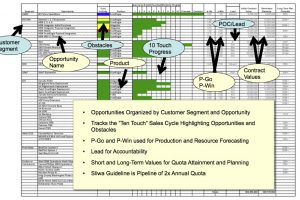 As the relationship evolves and a series of contacts and touches are utilized, it’s helpful to remind those in the business development, sales & marketing, development & fundraising roles that a lot of activity must be done to accomplish the large ‘sale.’ Every day should be filled with actions to support the contacts to support the touches.
As the relationship evolves and a series of contacts and touches are utilized, it’s helpful to remind those in the business development, sales & marketing, development & fundraising roles that a lot of activity must be done to accomplish the large ‘sale.’ Every day should be filled with actions to support the contacts to support the touches.
I also find the 10 Touch ‘Sales’ Model a useful way to track and report progress for various stakeholders like other employees and board members. To the right is a hyperlinked picture of a typical chart we used for the board and executive council, meaning the highest ranking VPs reporting to the CEO.
In this chart, we list all the opportunities vertically in rows, and in the middle, one clearly observes the 10 touches status as green horizontal bars. The farther the bar stretches to the right, the higher the touch level. At a glance, it is easy to see the relative maturity of the sales pipeline.
I remember at several board meetings when we reviewed the pipeline chart that some board members remembered the ‘shape’ of these lines from meeting to meeting. One remarked: Line item ‘x’ has been at Touch 5 for a long time, how come it hasn’t matured over the past 3 months? Another comment I remember was something like: Wasn’t line item ‘y’ at a Touch 7 last month, why is it down to a Touch 5?
We had interesting answers for each, but notice how it created an opportunity for a productive conversation. The fundamental understanding of 10 touches along with a pictorial representation made it easy to see the status of the sales pipeline and identify issues at the strategic and tactical levels.
Other columns in this Microsoft Excel chart include the Customer Segment, the Opportunity Name, Customer Activity Status, P-Go, P-Win, Point-of-Contact (POC) or Project Lead, and the Contract Values.
Customer Activity Status is basically a color-coded cell – blue, green, yellow, or red – used to give an overall indication if the trends are going well with the customer and the expected speed of closing a deal. For example: Ahead of Expectations, Proceeding as Expected, Some Warning Signs, or Stalled/In Trouble.
P-Go is the probability that a customer program or project will go forward, meaning the customer secures funding, gets required approvals, and completes the tender process.
P-Win is the probability that if the project goes forward, the customer will select you. So, the expected value of the opportunity is the P-Go times the P-Win times the size of the initial contract.
Under Contract Values, we usually kept columns for the projected size of an initial contract, amount of potential revenue this year, and long-term potential sales for this opportunity.
Statistics teaches us that the expected value of any particular opportunity is not likely to be useful because you never actually receive the expected value of a contract. You either win it, or you don’t. But over a large enough number of opportunities and with sufficiently good estimates for the probabilities, the sum of the expected values will trend toward a meaningful estimate of the expected value of the collection of opportunities.
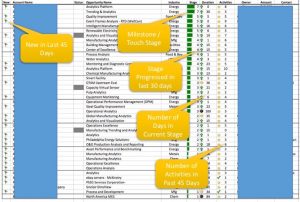 The second Pipeline chart example was adapted for selling software. This report was actually exported from SalesForce.com into MS Excel with some macros. The first column denotes a new opportunity; the ‘Status’ column has some special purpose, in this case, the gray blocks refer to customers waiting for a new software feature; the ‘Stage’ column is auto-generated by the Milestone/Touch Stage number saved with the opportunity; the up arrow, horizontal arrow, and black dot reflect how many days since a Milestone number has improved with a number alongside; and, the Activities column shows the number of various contacts to that customer in the past 45 days where 1 gets a check and more a star.
The second Pipeline chart example was adapted for selling software. This report was actually exported from SalesForce.com into MS Excel with some macros. The first column denotes a new opportunity; the ‘Status’ column has some special purpose, in this case, the gray blocks refer to customers waiting for a new software feature; the ‘Stage’ column is auto-generated by the Milestone/Touch Stage number saved with the opportunity; the up arrow, horizontal arrow, and black dot reflect how many days since a Milestone number has improved with a number alongside; and, the Activities column shows the number of various contacts to that customer in the past 45 days where 1 gets a check and more a star.
Assessing Step Levels
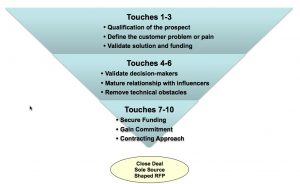 I personally view scaling to the touch level steps to be relative to a level of effort toward closing a deal. Touch 1 is when a prospect is qualified, and Touch 10 is when the contract has been awarded and signed and the opportunity is virtually certain of turning into revenue. One can think of reporting on the touches as being a linear progression toward an assessment of percent to complete. However, common steps are required in each sector of the 10-touch process, as depicted in the hyperlinked chart at the right.
I personally view scaling to the touch level steps to be relative to a level of effort toward closing a deal. Touch 1 is when a prospect is qualified, and Touch 10 is when the contract has been awarded and signed and the opportunity is virtually certain of turning into revenue. One can think of reporting on the touches as being a linear progression toward an assessment of percent to complete. However, common steps are required in each sector of the 10-touch process, as depicted in the hyperlinked chart at the right.
The first band of touches (1 through 3) is typically for qualifying the prospect, defining the customer problem or pain. And then, validate that you have a valid solution and that the customer is likely to find funds for such a solution. The second range (4 through 6) is generally where the hard work is done to shape the customer. The decision-makers are validated, relationships are built with key influencers, and technical obstacles/issues/unknowns are removed or mitigated. Finally, the third zone (7 through 10) is where we drive toward closure. Funding is secured, commitment is gained, and the contracting approach is finalized.
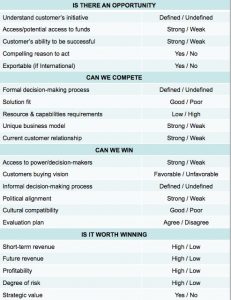 In the early steps, it’s important to assess this particular opportunity. One of the worst things is to believe a customer has the potential to close a deal, expend incredible amounts of effort trying to get to closure, and then discover that a deal isn’t going to happen and that this was a knowable outcome early on. It would be a horrendous waste of time, but the opportunity cost is likely to be even larger. That is, the wasted time prevents spending time pursuing leads/prospects that have a higher probability of closure.
In the early steps, it’s important to assess this particular opportunity. One of the worst things is to believe a customer has the potential to close a deal, expend incredible amounts of effort trying to get to closure, and then discover that a deal isn’t going to happen and that this was a knowable outcome early on. It would be a horrendous waste of time, but the opportunity cost is likely to be even larger. That is, the wasted time prevents spending time pursuing leads/prospects that have a higher probability of closure.
Best Practices
During my many years of leading sales, development/fundraising, and financing teams, I encountered many best practices. Here is a summary:
- Building Strategic and Tactical Plans. Every significant ‘sales’ opportunity requires a well-thought-out battle plan. The biggest opportunities are entitled to a full-fledged ‘war room’ with postings on the wall, full-time staff support, daily 8 am status updates, and team members flowing in and out as necessary. Smaller opportunities still need a planning cycle, and it’s up to the leadership to determine the level of effort for each opportunity. Some of the key aspects of these plans include:
- Identifying all of the ‘touch’ points, ‘contacts’ interfaces, and key influencers.
- Developing relationship maps for each of the key people within the influence chain.
- Laying out any supporting activities that are needed, such as marketing, trade shows, and white papers.
- Secure Funding for the Customer. Many times when making a ‘sale’ to an organization, the key person on the other side would like to buy your product or service but isn’t able to obtain the funds. The reasons could be an organizational priority, lack of visibility of the particular problem being solved, organizational log jambs, need for government approvals, or sometimes even that your particular customer contact doesn’t know how to get the money or exert influence within his/her organization. A sales team must solve all these issues and even help educate the customer on steps that need to be taken on his/her side.
- Touch People Matching. One necessary trick in the bag is to determine who should make each contact/touch based on the plans above, the relationship maps, the hierarchies, and relationship impedance matching. Every sales process requires this to be carefully tuned and orchestrated.
- For example, when involved in fundraising for the university, I was generally involved in the ‘heavy lifting’ at about Touch 4 and Touch 9. This gave the development team the opportunity to ‘build up’ the meeting with me so that it could be significant. If I made every call, contact, and touch, it wouldn’t be as special. It means when I help make ‘the ask,’ it can also be impactful.
- In contrast, when doing fundraising for venture capital, the expectation is that I, as the CEO, am involved in most of the touches, contacts, and calls.
- Relationship Impedance Matching. This concept is mentioned above and is where we try to match personalities and dynamics between the participants in a particular touch opportunity.
- Occasionally, sales teams and organizations rely too heavily on personnel titles and hierarchy to determine who makes particular calls and touches. For example, I am ‘good’ in sales calls, but I just do not sync with certain people. It would be better to not use me in situations where I could aggravate the sales process. So even though I was the CEO, I made it clear that we should always use the best person for each ‘touch’ interaction.
- This is really hard to do in big companies because org charts rule the day. One could argue it’s harder in engineering-type companies where IQs are usually more dominant than EQs. This should be underscored for both large and small companies. And, as we know, it’s more than just aligning the right technical-to-technical contacts, having the CEO make a touch at the right time, etc. … it’s also the non-business chemistry. Our experience at Insitu was alma maters, college football, hometowns, and the like.
My colleague, Steve Nordlund, has a cute anecdote: “I remember my meeting with a key admiral that ultimately championed us onto a certain class of ship in the US Navy. We were scheduled for 30 minutes, but the meeting actually went for an hour and a half. For all but 15 minutes, we talked about Apple computers after he saw my Mac laptop. Turned out, he was a closet Apple guy inside the DOD. He told me at the end of the meeting, he would get us on DDGs, and he did just that.” {Editor’s Note: This was Touch 3, and it still took us a full 10 touches, but the momentum was established.}
- Advisory Councils. I have used advisory councils to great effect. These are talented, experienced people with diverse backgrounds who can monitor the pulse of customer segments, give advice on positioning, arrange for meetings for the sales team, determine if customer communications are sufficient, and in the event of a problem, possibly intervene with the customer.
- Collecting Data Prior to Meetings. Prior to a major ‘touch,’ we try to use the opportunity’s relationship map and all our resources to determine the touch points and issues. It’s amazing how successful a meeting can be if the issues are successfully predicted and the materials are prepared that exactly address those concerns.
- Vocabulary. Although I have learned and adapted this approach using the terminology of ‘Touches’ and ‘Contacts,’ I have since evolved for my latest business endeavor and call them ‘Milestones’ and ‘Activities’ to increase clarity. The second pipeline example chart above reflects this update.
- Getting to a Quick No. It is important to trim down the opportunities to the one that is likely to close as soon as possible. Ten touches times 10 contacts per touch is a lot of activity that has to be organized. Disaster would be to get to the end and discover there is no match.
I remember when I was raising venture capital, and one friendly venture capital firm kept having me come back, make presentations, supply due diligence data, interface with colleagues, and channel my team to their issues. In the end, they said they didn’t want to make an investment because they don’t invest in that sector. Ouch! We wasted so much time. I asked them why they just didn’t tell me that at the start. They said, in effect, that they liked us and didn’t want to hurt our feelings. As can be imagined, their response was not appreciated.
Summary
Every organization in every sector needs to collect resources to execute its purpose. We have used the term ‘sales’ as the generic process for the collection of those resources. Herein a simple model is proposed and illustrated for discussing, reporting, organizing, and managing the ‘sales’ process.
Update: As CEO of Seeq, I updated the sales process model. Read this post for more information.
Share this Post
